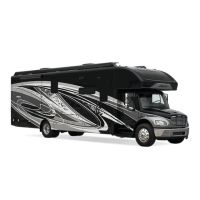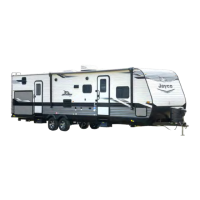58
Before replacing a fuse, always turn o the electrical components protected by it.
1. Disconnect the shore power cord.
2. Inverter should be OFF.
3. Remove the fuse panel cover to check fuses.
4. Pull the fuse straight out of the fuse block.
5. Insert a new fuse of the same specied voltage, amperage rating and type in the original
location.
The fuse panel label should be kept permanently axed to your recreation vehicle. Fuses
will not oer complete protection of the electrical system in the event of a power surge or
spike.
There may be one or more 12-volt DC power outlets in your recreation vehicle. When the
12-volt DC outlet is used as a power source for an electric appliance, make sure the appli-
ance operates on 12-volt DC power and that it consumes less than 60 watts (5 amps) of
power.
Keep the protective dust cap on the 12-volt DC outlet when not in use to pre-
vent ingestion of foreign material and potential short circuit conditions.
Batteries
or near the
batteries that could touch the battery or battery cable terminals. Contact
with the battery or battery cable terminals could cause an electrical short
circuit, discharge the batteries, or start an electrical re.
Do not connect a booster bat-
tery or other power source that outputs more than 14.2-volts DC to the
motor home batteries. Use adequate ventilation when charging or using
batteries in an enclosed space.
Remove metal jewelry and always wear eye protection when working
around batteries.
Electrolyte is a sulfuric acid solution
that could cause serious personal injury or property damage. If your
hands, eyes, clothes or the painted surface of your motor home are ex-
posed to electrolyte, ush the exposed area thoroughly with water. If
electrolyte gets in your eyes, immediately ush them thoroughly with
water and get prompt medical attention.
Keep the batteries
out of the reach of children.

